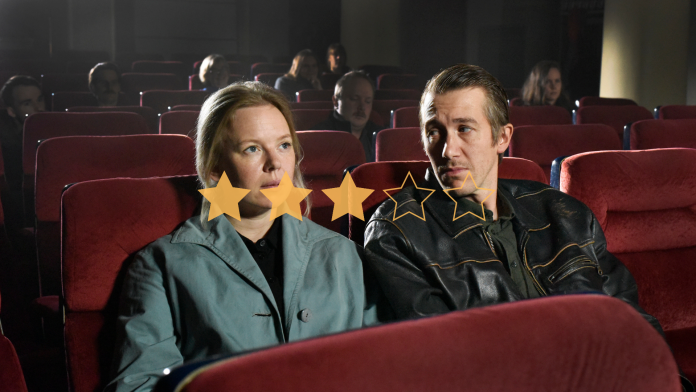Fallen Leaves (2023) succeeds in delivering a simplistic love story focused on the working class of Finland’s capital Helsinki. It combines the day-to-day struggles of the proletariat with the trials and tribulations of a romantic relationship, touching on the ways in which these different factors can catalyse and hinder the connection between two people. With two endearing characters supported by an imperfect yet subtle script, the film adequately explores its chosen themes through production and visuals.
★★★☆☆
Part of Aki Kaurismaki’s Proletariat series, Fallen Leaves is a satisfying look into the domestic struggles of ordinary singles living in Helsinki. The series itself explores the everyday lives of working-class people within the city. It’s the Finnish and modern-day equivalent of British kitchen-sink drama with its social realism. Fallen Leaves follows supermarket worker Ansa and alcoholic Holappa. Their meeting sparks something new and exciting in each of their dull and uneventful lives. However, lost phone numbers and train accidents leave the two unknowingly waiting for each other. The film examines the unfolding love-story of two downtrodden adults–taking their chances despite all the baggage that comes with that person. It’s a less dramatic and more thoughtful Serendipity (2001).
Romantic comedies often have larger-than-life characters with high ambitions, daring aspirations, and nine-to-fives in skyscraper buildings. Take magazine journalist Andie Anderson in How to Lose a Guy in 10 Days (2003) or The Prince in Red, White and Royal Blue (2023). Here however, it’s refreshing to see two characters fall in love despite the simplicity of their jobs–stacking shelves and doing construction work. What’s even more endearing is the shy approach to Ansa and Holappa’s relationship. It’s like puppy love, quiet and demure, but determinedly persistent. This is down to the modest performances of Alma Pöysti as Ansa and Jussi Vatanen as Holappa.
Of course, the two have their disagreements and miscommunications, but the beauty of the film is that it does not over-bloat or exaggerate these squabbles, unlike most love stories in their pursuit of drama. There are misgivings and misunderstandings, but the film handles these rifts with mature conversations and understandings between Ansa and Holappa. Kaurismäki uses space and time to heal his characters. Most importantly, he lets the parallels between their lives–the way they relate to each other and their similar circumstances–stand as the foundation for their mutual forgiveness.
Instead of going into the dramatics, Fallen Leaves takes time to explore themes of subtle misogyny, abusive work environments, capitalism, desensitization to war, and the leaps of faith taken to make a relationship work. All of these surrounding themes allow Ansa and Holappa to bloom as characters. They both have their battles outside of the constant chase for love. But in the end, it’s their strong connection that keeps them falling back into each other. However, the script does have some questionable pieces of dialogue regarding the two, particularly Ansa’s rants about Holappa. The film never establishes Ansa’s history of bad relationships, and so her lines criticizing Holappa often feel gimmicky or throwaway. Script inconsistencies also crop up elsewhere, such as in Ansa’s surprise at Holappa’s alcoholism despite having encountered him passed out at a bus stop before their first date.
Visually, the film uses low-saturation filters to give each scene a pastel-like effect. This accentuates the exploration of the working class alongside paper walls and the clash of kitsch and minimalist set design. The romance aspect is highlighted by a soundtrack with lyrics relating to the characters’ plights. For example, “Why won’t you answer me, don’t you dare love me” lingering in the background as Ansa awaits Holappa’s call. The use of pathetic fallacy with the rain only further adds to the effect. Lastly, the use of symmetry is an excellent visual reference to the loneliness both characters feel. Centre-framing of the characters signals the vast expanse of space that shows their desire for companionship. Meanwhile, shots through windows with the frames acting almost like cages symbolizes the working-class life that neither can escape.
The Verdict
Fallen Leaves has a creative premise and the idea of focusing on the working class is a much-appreciated sentiment. Without the glamour and cinematic bravado of typical romance films, it opens itself up to the vulnerability of two characters looking for human connection on top of financial struggles and work-life disputes. Ansa and Holappa’s search for each other is a fulfilling quest for the viewer. Their persistence to reconnect despite circumstances in life preventing them truly communicates the lesson that money means nought without companionship. The script is subtle and clever when it comes to building this downtrodden world in which the characters live in. With the support of production, the visual execution of the themes is a marvel. However, shortcomings with the dialogue and certain interactions between the characters that detract from the verisimilitude prevents the film from truly excelling.
Words by Mae Trumata
Support The Indiependent
We’re trying to raise £200 a month to help cover our operational costs. This includes our ‘Writer of the Month’ awards, where we recognise the amazing work produced by our contributor team. If you’ve enjoyed reading our site, we’d really appreciate it if you could donate to The Indiependent. Whether you can give £1 or £10, you’d be making a huge difference to our small team.
